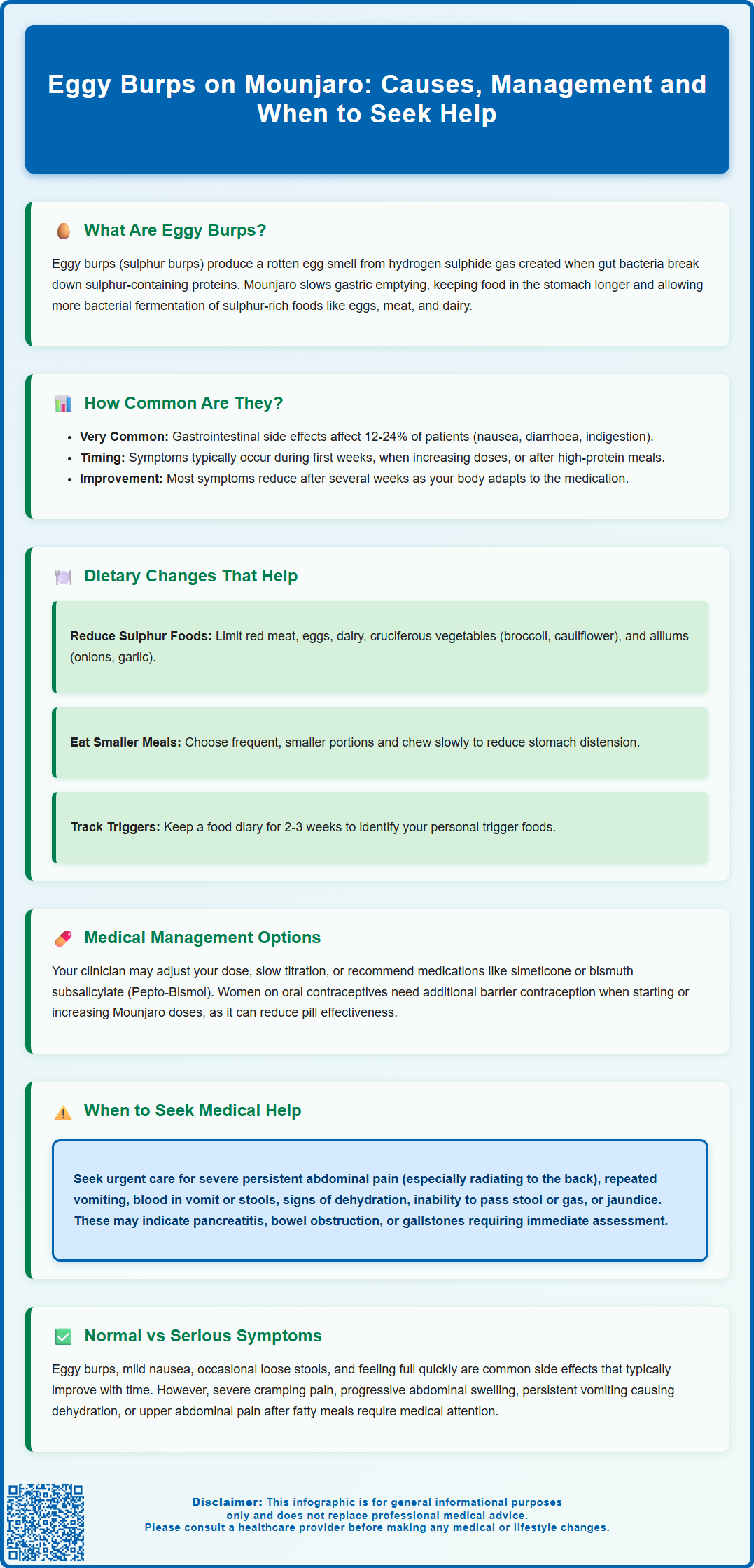Mounjaro®
Dual-agonist support that helps curb appetite, hunger, and cravings to drive substantial, sustained weight loss.
- ~22.5% average body weight loss
- Significant weight reduction
- Improves blood sugar levels
- Clinically proven weight loss

Eggy burps on Mounjaro (tirzepatide) are characterised by belching with a distinctive rotten egg odour caused by hydrogen sulphide gas. This gastrointestinal side effect occurs in some patients taking this dual GIP and GLP-1 receptor agonist for type 2 diabetes management. The symptom relates to Mounjaro's mechanism of slowing gastric emptying, which can increase bacterial fermentation of sulphur-containing foods in the digestive tract. Whilst unpleasant, eggy burps are generally not dangerous and often improve as the body adjusts to treatment. Understanding their cause, management strategies, and when to seek medical advice helps patients navigate this common side effect whilst maintaining therapeutic benefit from tirzepatide.
Summary: Eggy burps on Mounjaro occur due to tirzepatide slowing gastric emptying, which increases bacterial fermentation of sulphur-containing foods and produces hydrogen sulphide gas.
Eggy burps, medically termed sulphur burps or eructation with hydrogen sulphide, are characterised by belching that produces a distinctive rotten egg odour. This unpleasant smell results from hydrogen sulphide gas produced during the breakdown of sulphur-containing proteins in the digestive tract. Whilst occasional sulphur burps can occur in anyone, they have been reported by some patients taking Mounjaro (tirzepatide), a dual glucose-dependent insulinotropic polypeptide (GIP) and glucagon-like peptide-1 (GLP-1) receptor agonist approved in the UK for type 2 diabetes management.
The mechanism behind eggy burps on Mounjaro may relate to the drug's pharmacological action. Tirzepatide slows gastric emptying—the rate at which food moves from the stomach into the small intestine—particularly during treatment initiation and dose escalation periods. This delayed transit time means food remains in the stomach longer, potentially creating conditions where bacterial fermentation of sulphur-containing foods may increase. When sulphur-containing foods such as eggs, meat, dairy products, and certain vegetables undergo digestion, gut bacteria can produce hydrogen sulphide gas as a metabolic by-product.
It's important to note that sulphur burps can have multiple causes beyond medication effects, including dietary factors (high sulphur foods), infections (such as Helicobacter pylori or giardiasis), or small intestinal bacterial overgrowth (SIBO). If sulphur burps persist or are particularly troublesome, discussing this with your healthcare provider can help determine whether they're related to Mounjaro or have another cause.
Whilst unpleasant, eggy burps are generally not dangerous and often improve as your body adjusts to treatment. The gastric-slowing effect of tirzepatide typically becomes less pronounced over time with continued treatment at a stable dose.

Gastrointestinal side effects are amongst the most frequently reported adverse reactions with Mounjaro, though specific data on sulphur burps is not captured as a distinct category in clinical trials. In the SURPASS clinical trial programme evaluating tirzepatide, common gastrointestinal symptoms included nausea (reported in 12-24% of patients), diarrhoea (13-22%), vomiting (2-10%), and dyspepsia (indigestion). The frequency of these effects generally increased with higher doses.
Whilst sulphur burps were not specifically categorised as a distinct adverse event in these trials, they fall within the broader spectrum of gastrointestinal disturbances that patients may experience.
Gastrointestinal symptoms, which might include eggy burps, are typically most noticeable during:
Treatment initiation: The first few weeks when the body adjusts to the medication
Dose escalation periods: When transitioning to higher maintenance doses
After consuming sulphur-rich meals: Particularly high-protein or high-fat foods
The severity and frequency of gastrointestinal effects, including sulphur burps, show considerable variation between individuals. Some patients report only occasional episodes, whilst others experience more frequent symptoms. Importantly, gastrointestinal side effects often diminish over time as physiological adaptation occurs. Many patients notice improvement after several weeks of consistent dosing, though individual experiences vary.
Gastrointestinal effects are a recognised feature of GLP-1 receptor agonists as a drug class. If you find these symptoms particularly troublesome, your healthcare provider can discuss management strategies or alternative treatment options. Experiencing these side effects does not indicate treatment ineffectiveness, and many patients continue to benefit from therapy despite initial digestive symptoms.
Management of eggy burps on Mounjaro should begin with a discussion with your prescribing clinician, who can assess symptom severity and rule out other gastrointestinal conditions. Several medical strategies may help reduce sulphur burps whilst maintaining therapeutic benefit from tirzepatide.
Pharmacological approaches that your healthcare provider might consider include:
Dose adjustment: Temporarily reducing the Mounjaro dose or slowing the titration schedule may allow better gastrointestinal tolerance
Proton pump inhibitors (PPIs): Medications such as omeprazole or lansoprazole may be considered if you also have acid reflux or dyspepsia, though these should be reviewed after 4-8 weeks and evidence for sulphur burp reduction specifically is limited
Simeticone: This anti-foaming agent helps break up gas bubbles and may provide symptomatic relief for some patients
Bismuth subsalicylate: Available over-the-counter (e.g., Pepto-Bismol), this can reduce hydrogen sulphide production. However, it should be avoided if you have aspirin/salicylate allergy, are taking anticoagulants like warfarin, have gout, are pregnant or breastfeeding, or are under 16 years old. Always discuss with your GP before using
Important medication considerations:
Mounjaro is not recommended for people with severe gastrointestinal disease, including severe gastroparesis
If you use oral contraceptives, be aware that their effectiveness may be reduced during Mounjaro initiation and dose increases due to delayed gastric emptying—consider additional non-oral or barrier contraception during these periods
When to seek urgent medical advice:
Whilst eggy burps are generally benign, certain accompanying symptoms warrant prompt professional assessment:
Severe, persistent abdominal pain that does not resolve
Repeated vomiting, particularly if unable to keep fluids down
Signs of dehydration: reduced urination, dizziness, extreme thirst
Blood in vomit or stools
Unexplained fever alongside gastrointestinal symptoms
Symptoms of pancreatitis: severe upper abdominal pain radiating to the back
Jaundice: yellowing of skin or eyes
Your GP or diabetes specialist nurse can provide individualised guidance. In some cases, switching to an alternative diabetes medication may be appropriate if symptoms prove intolerable despite management strategies. Never discontinue Mounjaro without medical supervision, as this may affect glycaemic control.
Strategic dietary adjustments can help manage eggy burps whilst taking Mounjaro. Since sulphur burps result from bacterial fermentation of sulphur-containing compounds, identifying and moderating intake of high-sulphur foods may help reduce symptom frequency and severity.
Foods to consider reducing if they trigger symptoms:
High-sulphur proteins: Red meat, eggs (particularly egg yolks), poultry, and certain fish
Dairy products: Milk, cheese, and whey protein supplements
Cruciferous vegetables: Broccoli, cauliflower, Brussels sprouts, cabbage, and kale
Allium vegetables: Onions, garlic, leeks, and shallots
Other sulphur-rich foods: Asparagus, dried fruits (containing sulphur dioxide preservatives), beer, wine, and certain nuts
Rather than eliminating these nutritious foods entirely, consider testing which ones specifically trigger your symptoms and adjusting portions accordingly. Maintaining adequate protein and overall nutrition remains important, especially for people managing diabetes or weight.
Eating pattern modifications that may help include:
Smaller, more frequent meals: Reducing meal volume decreases gastric distension and may improve comfort
Slower eating pace: Thorough chewing and mindful eating reduce air swallowing (aerophagia), which can exacerbate burping
Avoiding late evening meals: Allowing 3–4 hours between dinner and bedtime gives the stomach time to empty
Reducing dietary fat: High-fat meals further delay gastric emptying, potentially compounding Mounjaro's effects
Limiting carbonated beverages: These introduce additional gas into the digestive system
Other dietary strategies to consider:
Adequate hydration: Drinking water throughout the day supports overall digestion
Ginger: Some people find ginger tea or fresh ginger provides digestive comfort
Peppermint: May soothe the digestive tract for some, though avoid if you have gastro-oesophageal reflux as it can worsen symptoms
Probiotic foods: Natural yoghurt (choose unsweetened varieties for better glycaemic control) or kefir might help, though evidence for their effect on sulphur burps specifically is limited
Keeping a food and symptom diary for 2–3 weeks can help identify personal trigger foods. A registered dietitian with experience in diabetes management can provide tailored advice that balances symptom control with nutritional adequacy and glycaemic management goals.
Whilst eggy burps and mild gastrointestinal discomfort are common and generally benign side effects of Mounjaro, it is crucial to recognise warning signs that may indicate more serious complications requiring immediate medical attention. Understanding these distinctions empowers patients to manage expected side effects confidently whilst remaining vigilant for concerning developments.
Expected gastrointestinal side effects that typically do not require urgent intervention include:
Sulphur burps without severe pain
Mild to moderate nausea, particularly after meals
Occasional loose stools or mild constipation
Feeling of fullness or early satiety
Mild, intermittent abdominal discomfort
These symptoms, whilst unpleasant, generally improve with time, dietary modification, and symptomatic management.
Serious complications that warrant immediate medical assessment:
Acute pancreatitis: Mounjaro carries a warning regarding pancreatitis risk. Symptoms include severe, persistent upper abdominal pain (often radiating to the back), nausea, vomiting, and fever. This constitutes a medical emergency requiring hospital assessment.
Severe gastroparesis: Whilst delayed gastric emptying is expected, severe cases may present with persistent vomiting, inability to tolerate oral intake, significant weight loss beyond expected therapeutic effect, and severe abdominal distension. Note that Mounjaro is not recommended for people with pre-existing severe gastrointestinal disease, including severe gastroparesis.
Bowel obstruction: Severe, cramping abdominal pain, absolute constipation (no passage of stool or wind), progressive abdominal distension, and vomiting require urgent evaluation. This is a general medical emergency rather than a specific medication effect.
Gallbladder disease: Rapid weight loss associated with Mounjaro increases cholelithiasis (gallstone) risk. Right upper quadrant pain, particularly after fatty meals, alongside nausea and possible jaundice, suggests biliary pathology.
Dehydration from persistent vomiting or diarrhoea: Signs include reduced urine output, dizziness on standing, extreme thirst, and confusion.
If you experience persistent symptoms that significantly impair daily function or any red flag features, contact your GP promptly or attend A&E if symptoms are severe. You can report suspected side effects to medicines via the MHRA Yellow Card scheme at yellowcard.mhra.gov.uk or via the Yellow Card app. Most patients tolerate Mounjaro well with appropriate support, but individualised risk-benefit assessment remains essential throughout treatment.
Eggy burps on Mounjaro typically improve after several weeks of consistent dosing as your body adjusts to the medication. They are most common during treatment initiation and dose escalation periods, with many patients experiencing reduced symptoms once established on a stable maintenance dose.
Simeticone (an anti-foaming agent) or bismuth subsalicylate may provide symptomatic relief for sulphur burps. However, always consult your GP before using bismuth subsalicylate, particularly if you take anticoagulants, have aspirin allergy, gout, are pregnant, breastfeeding, or under 16 years old.
Never discontinue Mounjaro without medical supervision, as this may affect your glycaemic control. Speak with your prescribing clinician about persistent eggy burps—they can assess symptom severity, suggest management strategies including dietary modifications or dose adjustments, or discuss alternative treatments if symptoms prove intolerable.
The health-related content published on this site is based on credible scientific sources and is periodically reviewed to ensure accuracy and relevance. Although we aim to reflect the most current medical knowledge, the material is meant for general education and awareness only.
The information on this site is not a substitute for professional medical advice. For any health concerns, please speak with a qualified medical professional. By using this information, you acknowledge responsibility for any decisions made and understand we are not liable for any consequences that may result.
Lorem ipsum dolor sit amet, consectetur adipiscing elit, sed do eiusmod tempor incididunt ut labore et dolore magna aliqua. Ut enim ad minim veniam, quis nostrud exercitation ullamco laboris nisi ut aliquip ex ea commodo consequat. Duis aute irure dolor in reprehenderit in voluptate velit esse cillum dolore eu fugiat nulla pariatur.
Block quote
Ordered list
Unordered list
Bold text
Emphasis
Superscript
Subscript